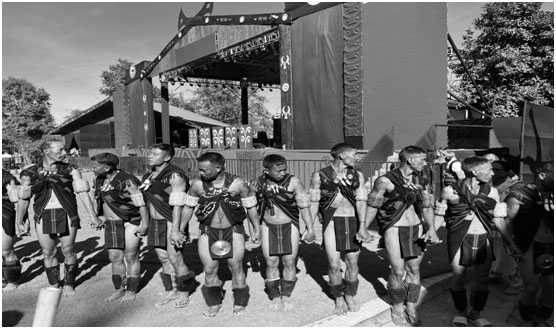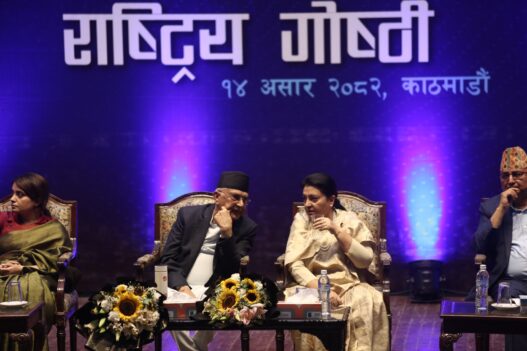In the heart of Nagaland, the month of December is believed to be the liveliest chapter, becoming a celebration for its residents where the first ten days of the month, from December 1 to 10, holds a significant role in orchestrating this festive symphony.
As a local immersed in the cultural tapestry of Nagaland, the Hornbill Festival presented a unique experience as it was not just a commemoration of six decades of statehood, but also a testament to the festival’s journey since its inception in 2000.
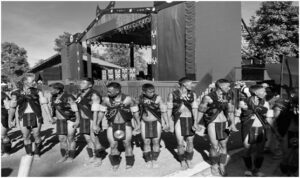
Amidst the celebration, the cultural showcase unfolded with all the 17 tribes taking the stage. Witnessing the distinct performances, through dance, songs, and music, painted a vibrant mosaic of heritage, I felt a sense of astonishment and pride in our roots and how I wished our ancestors were alive to see this festival. And so, as the festival unfolded, I could not help but recognise its significance, a pride that will continue to echo through the days to come.
During this year’s edition, there was an air of warmth, unity and brotherhood casting a spotlight on the rich cultural heritage and traditions that define the state or the significance of the occasion, perhaps owing to the pride of celebrating six decades of statehood.
Regardless of the reason, one thing remains certain—the Hornbill Festival continues to be a source of pride for the people of Nagaland, standing resilient through the years.
As the beats of tradition echoed through the air and the hues of cultural expression illuminated the festival grounds, it became clear that the Hornbill Festival is not just an event; it is a narrative of identity, unity, and cultural richness.
Preserving traditions against the fast changing time
A significant avenue for preserving cultural traditions is through celebrations such as this, and the Hornbill Festival lives up to its name as the “festival of festivals.” Traditions, acting as conduits for passing down knowledge and skills through generations, are revered; however, they are also transitioning into a more modern era.
The Hornbill Festival has transformed from its origins as a celebration of the culture and traditions of the Naga tribes into a dynamic platform for cultural exchange, community gatherings, and a showcase for local entrepreneurs from the state. As the state embraces modernity and its youth adapt to contemporary influences, the festival has expanded from a two-day event to a ten-day celebration where each year, the festival comes alive with different stories as people gather to celebrate traditions.
In the heart of Kohima village, a group of wise elderly women known as the Lidi Kro-u Society has embarked on a mission to pass down the ancient ways of our ancestors to the younger generation to revive the fading art of bamboo weaving and crafting. As part of the Hornbill Festival, they elevated the promotion and preservation of traditional skills to a grand stage from November 4th to 8th.
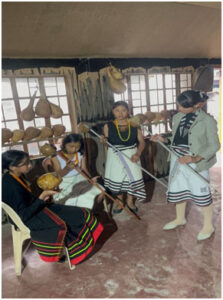
These seasoned women gathered children and took center stage during the festival, showcasing various demonstrations from weaving to bamboo crafts, storytelling about ancestors, and screening documentaries.
The Lidi Kro-u Society was born in 2012, with a simple goal: to breathe life into and celebrate the distinctive culture and traditions of the Angami Naga culture. On November 2022, they found themselves in the spotlight on the 95th episode of Mann Ki Baat, where Prime Minister Narendra Modi commended their efforts in preserving and promoting Naga culture.
Nagaland’s history is woven with fascinating traditions, but the winds of change threaten to carry them away from the younger generation. Recognising this, the Lidi Kro-u Society dreams of establishing a cultural institute in Nagaland envisioned to promote and preserve the culture and traditions which were passed down from our ancestors and where young minds can delve into their roots, learn the essence of their culture.
Stone pulling- an experience of a lifetime
On the 7th of December, amidst the mist-covered hills of Kohima village, a timeless tradition unfolded, orchestrated by the venerable Tsütuonuomia Khel Council. As a proud member of this ancient clan, I found myself swept up in an experience of a lifetime during the Hornbill Festival.
The rain, undeterred by the grandeur of the occasion, could not dampen the spirits of the thousands who gathered, draped in the traditional Angami Naga attire. Men, both seasoned by years and spirited with youth, united on a Thursday for the ancient rite of gate-pulling of a colossal wooden Naga village gate, a symbol of heritage and fortitude, measured an impressive 10.11 feet by 5.8 feet.
The procession unfolded along National Highway 29, stretching over 3 kilometers from the quaint Merhülietsa to the T Khel Model village in Seithogei, followed by a sea of elders, womenfolk, and children, all adorned in the sacred garb of their forefathers, walked in unison.
The story of this day reached far beyond the boundaries of Kohima, as thousands from 25 villages participated in the ancient rite of gate-pulling with participants voicing a collective sentiment to unfurl the tapestry of their state’s rich culture and traditions to the world.
Mothers’ care : a tale of determination
In a tale of mothers passing down traditions through their handmade cuisine, a quartet of mothers has embarked on crafting the traditional Sticky Rice roti—a popular afternoon tea-time snack. This festival served as a platform to acknowledge and recognise the efforts of this group, aptly named “Mother’s Care.”
Confronting the uncertainties of irregular employment and financial instability, these mothers discovered a distinctive way to sustain their families by skillfully preparing and selling handmade rotis, even if only for a temporary period of 10 days.
Originating from Sechü-Zubza, Kidima, and Jakhama, this group, affectionately known as “Mothers Care,” is led by the indomitable Neichümenuo Sechü (62), and comprises of members Akhoü Sechü, Rovihuü Sechü, Kevizenuo Zhünyü, Keneileno Rote, Neibano Sophie, Vitomenuo Rhatsu, and Vitoyngulie.
Neichümenuo shared that the idea took root when she learned about the opportunity to set up a stall in Kisama for the Hornbill Festival, conveyed through a closed connection in the Department of Tourism. In response, she rallied her friends and two kids, giving rise to the formation of the group.
Their first day of operation witnessed the skillful use of nearly 9 kg of ingredients to prepare the renowned Kemenya roti, which is unfermented, deep fried bread made out of pounded rice. As they delved into the second day, the team shared that they employed over 10 kg of rice powder in the early evening.
In sourcing their primary ingredient, glutinous rice, the Mothers Care group looks to the Lal Mati region for the finest quality. Beyond their signature sticky rice roti, the stall offered a diverse array of beverages, including lemon tea, rosel tea, ginger ale, chai, and the popular Angami naga tribe cuisine, galho.
Tikhir tribe joins 24th Hornbill festival
In a celebration of tribes coming together, the newly formed Tikhir tribe joined the celebration this 24th Edition of the Hornbill Festival in Kisama. The tribe emerged as distinguished participants, marking their official recognition as a separate Naga tribe on April 2, 2023.
Yanstuthong Tikhir, the 43-year-old Chairman of Pokphur village, stood proud at the Tikhir Morung in Naga Heritage Village, sharing insights into their inaugural experience at the renowned 10-day festival. A dedicated group of 51, comprising 21 men and 29 women aged between 35 and 50 years, undertook a journey covering 307 km in 17-18 hours to be part of the celebration.
As first-time participants, the Tikhir troops juggled excitement and nervousness, driven by the high expectations surrounding their cultural presentation. Despite the pressure, they prepared folk songs, adorned themselves in traditional costumes, all accomplished within a tight timeframe of three days.
Expressing gratitude to the state government for the opportunity to showcase their rich traditions, Chairman Yanstuthong Tikhir acknowledged the time constraints while emphasising their commitment to displaying the cultural heritage of the Tikhir tribe. Looking ahead, he conveyed the troops’ enthusiasm for grander preparations in 2024, anticipating the 25th anniversary of the Hornbill Festival.
In 2022, the construction of the Tikhir Morung laid the foundation for their participation, though circumstances led to a missed opportunity in the 23rd edition. The Chairman shed light on the Tikhir farming system, emphasising the significance of jhum cultivation. He highlighted a need for skilled farmers proficient in terrace paddy cultivation, suggesting that support from the state government in terms of skill development and aid would greatly benefit the community.
Diving into the culinary traditions, the Chairman revealed that Jobs tears and millets held integral places in their dietary habits, with millets being the predominant staple. The Tikhir region, home to a population ranging from 16,000 to 17,000, takes pride in its close boundary with Myanmar, boasting 16 km of untouched virgin forest.
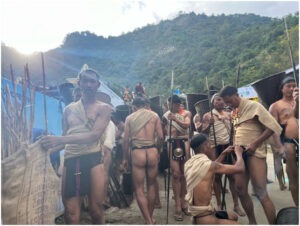
A thought of realisation
What guides us to the sustenance of this festival are these narratives that shape the true significance and purpose of the people, celebrated by locals and tourists from all over the world every year.
The Hornbill Festival is not just for tourists, it serves as a wake-up call for us locals like me, highlighting how our own culture and traditions are fading away, while also adapting and evolving with the modern times. It is a stark reminder of how we have adopted Western influences, from our food and language to the clothes we wear.
This festival becomes a crucial moment to witness the richness of our age-old traditions. While learning that the newly recognised Tikhir tribe joyfully participated in the 24th Hornbill Festival, I am amazed at the variety in language, culture, and traditions that have been handed down through generations in Nagaland.
As the festival comes to a close for the year, the collective display of unity and diverse cultures by the 17 tribes lingers in my memory, instilling a sense of pride for our journey and the blessings we cherish. This event reminded me of a saying that people have always been, are, and will forever be our most valuable assets.

